The mining segment and the world’s largest equipment fair continues to build momentum
By Steve Fiscor, Editor-in-Chief
When Messe München and the German Engineering Federation (VDMA) announced that they expected a strong turnout, they had no idea attendance would reach record levels. More than 530,000 visitors from 200 countries passed through the fairground’s turnstiles in Munich between April 15 and 21. No matter how a trade show is judged, bauma 2013 broke all previous records for visitors, number of exhibitors and exhibition space.
bauma takes place every three years. In 2010, an ash cloud from an Icelandic volcano prevented many people from attending the event. Had the event taken place as planned, the attendance would have been lower than that of 2007. Many economies were still recovering from the global financial crisis, which devastated the construction market. bauma 2007 was an extremely healthy fair, which took place about 18 months before the financial crisis brought the global economy to its knees.
While the mining business suffered some setbacks related to the financial crisis, only now is the construction industry beginning to recover. The turnout for bauma 2013 is yet another signal that the clouds may be clearing. Klaus Dittrich, chairman and CEO of Messe München, said the response this year has simply been outstanding.
“This is very good for our industry in these turbulent times and it will certainly give it a boost,” said Johann Sailer, chairman of the Construction Equipment and Building Material Machinery Association of VDMA and president of the Committee for the European Construction Equipment Industry (CECE).
In total, 3,420 exhibitors (1,346 from Germany) from 57 countries presented their latest products and innovations in construction and mining machinery at bauma 2013 on 570,000 m2. The landmark for the outdoor area was thehaul truck and mining class excavator on the Liebherr stand, which was an exhibit unto itself. “This has been an absolutely positive trade show for us,” said Stefan Heissler, member of the Liebherr-International AG board of directors. “We welcomed customers from around the world at our booths and we signed lots of new orders. In some product sections we exceeded our expectations by a long way.”
The activity in Mining Hall C2 was brisk. Engineering & Mining Journal (E&MJ) was the only major international mining trade journal with a stand in the mining hall. Large groups of miners from Russia, Indonesia and various African outposts stopped to visit. While E&MJ carried a number of announcements in its March edition related to bauma, exhibitors made more announcements at the show. What follows is a collection of announcements from a dozen or so vendors who support the mining sector. The next bauma will take place April 11-17, 2016, in Munich.
Liebherr Takes Center Stage
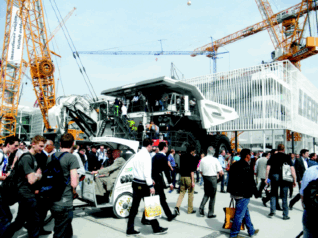 |
| A 240-ton Liebherr T 264 haul truck paired with a R 9400 excavator serve as a focal point for the outdoor exhibit. |
Liebherr returned to the 240-ton class in presenting the T 264 mining truck at bauma 2013. The company sees this as a way to synergize with mining-class hydraulic excavators. Backed by 30 years of proven design and operational experience, this fuel-efficient mining truck is built for safety and reliability, and is sized to match the Liebherr R 996 B and R 9800 hydraulic excavators, as well as electric shovels and wheel loaders for optimal performance.
With a gross vehicle weight of 385 metric tons (mt) and a payload of 240 tons, the T 264 can reach top speeds of 64 km/h (40 mph).
The T 264 combines an efficient Litronic Plus AC drive system and a high power engine (up to 2,700 hp/ 2,013 kW) to yield higher speeds on grade. For superior productivity, the T 264’s hydraulic system offers efficient dump hoist performance that promotes fast cycle times.
The T 264 is equipped with ladders designed for easy engine and alternator access from both sides of the chassis. Filling points for fuel, hydraulic oil, grease and coolant are all accessible at ground level. The hydraulic filters and the battery isolation box are also accessible from ground level. Low working heights of maintenance areas promote safe and efficient service.
The T 264 features high-powered, frictionless dynamic braking. The AC drive system delivers up to 4,425 hp / 3,300 kW of electric dynamic braking, reducing engine loading and fuel consumption.
The T 264 is designed to operate for approximately 24 hours without refueling, dependent upon application. The extended operation is supported by its low fuel consumption and 1,300 gallon/4,920 liter fuel capacity.
ThyssenKrupp Resource Technologies
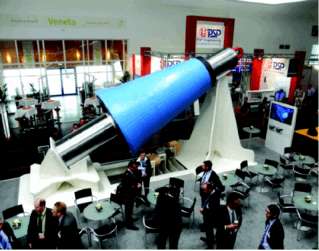 |
| It’s a large spindle for a crusher, but it’s not the largest spindle ThyssenKrupp Resource Technologies makes. |
ThyssenKrupp used bauma 2013 as a platform to discuss the merging of two engineering subsidiaries that work closely with the mines: ThyssenKrupp Fördertechnik and ThyssenKrupp Polysius. The new group will now be known as ThyssenKrupp Resource Technologies. With around 5,500 employees and annual sales of about €2 billion, the new company will be one of the world’s largest suppliers for mining, mineral processing and bulk materials handling systems. It will offer single-source expertise ranging from design and consulting to engineering and project management to construction and installation, after-sales service, research and development, and plant financing.
Dr. Hans Christoph Atzpodien, CEO of the Industrial Solutions business area of ThyssenKrupp AG, discussed the strengths of the new company. “Our comprehensive engineering know-how covers solutions from single machines to complete plant,” Atzpodien said. “With growing environmental awareness and rising raw material and energy prices, this engineering expertise provides our customers with a significant competitive edge.”
The management board of Thyssen-Krupp Resource Technologies now consists of Ramsis Shehata (CEO), Christof Brewka (service business), Heike Franke (CFO), Martin Hilbig (CHRO) and Lothar Jungemann (cement business).
The group’s product range includes bucketwheel excavators; conveyor systems; crushing, grinding and processing plants; stockyard and port handling systems for bulk materials; as well as cement plants. Lifecycle support can be provided for all products, as well as 24/7 service for individual machines or plants.
MTU Showcases Engines and Gensets
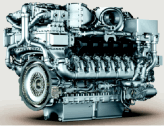 |
| MTU’s 12V4000 diesel engine. |
The Tognum Group presented its MTU diesel engines and MTU Onsite Energy gensets that deliver outputs from 100 to 3,000 kW and are able to meet the EU Stage IV and the U.S. Environmental Protection Agency Tier 4 final emissions regulations that will be coming into force in the future. In the open-air area of the show (45A, section 106), MTU Onsite Energy demonstrated its diesel gensets for power generation.
For power outputs under 560 kW (underground vehicles), MTU presented its 4- and 6-cylinder Series 1000 inline engines and 6-cylinder Series 1100, 1300 and 1500 inline engines. Equipped with SCR, these engines comply with the EU Stage IV and EPA Tier 4 final requirements to apply from 2014.
From 2014, 10 and 12-cylinder Series 1600 units will be extending the engine range available up to 730 kW. These off-highway engines are suitable for use in haul trucks, wheel loaders, pump drives and mining vehicles. They meet EPA Tier 4 final requirements through the use of high-pressure common rail injection, two-stage turbocharging, and exhaust gas return with cooling system. To keep fuel consumption as low as possible, MTU has focused strongly on optimizing combustion processes. Overall, customers benefit from the low operating and conversion costs of the integrated system.
MTU’s product portfolio also includes 12- and 16-cylinder Series 2000 engines covering outputs from 567 to 1,000 kW for use in mining vehicles. EPA Tier 4 engines using in-engine technology are only available in the 783 to 970 kW power range. MTU supplies Series 4000 engines with 8, 12, 16 and 20 cylinders for outputs up to 3,000 kW and these meet the EPA Tier 4 legislation that applies in the U.S. without the need for exhaust after-treatment.
A new addition to the line is the 12-cylinder Series 4000 version that is compliant with EPA Tier 4 interim rules. These engines are built for long-term service in wheel loaders, excavators, haul trucks, construction machinery for underground mining applications, and in heavy-duty mining vehicles for operation in surface mines and stone quarries. MTU’s renowned Series 2000 and 4000 units continue to be available for countries with higher emissions thresholds.
Fluid Coupling for High Powered Belt Conveyors
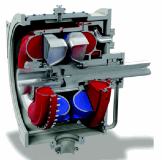 |
| Voith’s TurboBelt 780 TPXL fluid coupling. |
Voith displayed the TurboBelt 780 TPXL, a fluid coupling developed for large conveyor drives. An innovative XL blade wheel profile transmits twice the power previous couplings of similar size could achieve. It is designed for 6- and 8-pole induction motors operating at speeds of 900 to 1,200 rpm. The start-up with precisely-controlled introduction of torque not only protects the belt, but also the entire driveline. Even overloaded conveyors can be started reliably. Start-up times of up to several minutes can be individually set in the control system.
This new fluid coupling was first put to the test in May 2012 at one of the largest iron ore terminals in northern Brazil. The operator decided to install three TurboBelt 780 TPXL couplings in the drives of a 1,451-m (4,760-ft) long conveyor. The couplings and conveyor system operated smoothly. As the conveyor transports around 10,000 metric tons per hour (mt/h) of iron ore, reliability was a high priority. When combined with reliable mechanics, the hydrodynamic TurboBelt 780 TPXL coupling provides extremely high system availability of up to 99.8%.
Maintenance concerns are minimized as the hydrodynamic power transmission is completely wear-free. Compared with traditional couplings, the TurboBelt 780 TPXL requires only half as much installation space and is also significantly lighter. Altogether, the couplings helped increase the productivity and profitability of the belt conveyor.
To operate the conveyors in the most efficient way, Voith offers not only couplings, but also optimal drive solutions. The drive package solutions include the drive hardware, PLC controller and supervision of installation as well as commissioning.
Integrating Power Technology for Mining
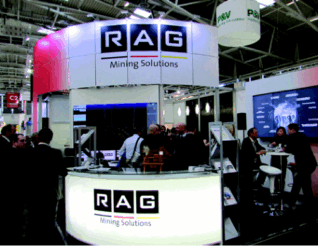 |
| RAG’s stand was in the center of Mining Hall C2. |
The theme for the Siemens stand at bauma was Drive Your Mining Business with Siemens. For 85 years, Siemens has been working with the mining business adapting electrical technology to meet the industry’s needs. In the 1950s, it introduced the Ward-Leonard drive system. In 1976, they introduced AC drive systems for electric shovels, and in the mid-1980s, Siemens began to embrace gearless drive technology, installing systems on conveyors, bucketwheel excavators, draglines, and grinding mills. Today, they are looking at how they can help mine operators integrate all of their systems to meet today’s business demands.
If a service provider wants to help a mining company, it has to understand today’s circumstances. Mining companies are struggling with huge cost overruns on development projects. They are working in more remote areas with declining ore grades and fewer skilled workers. “Mining projects are major investments that combine hundreds of different components and making sure all of the interfaces work well is very important,” said Edzard Lübben, executive vice president-minerals, Siemens.
Explaining the Siemens approach to system-wide integration, Lübben offered a traditional drive system as a starting point. “It typically has electric motors, frequency converters and gearboxes, and we make sure that everything works well within that system [horizontal integration]. Then we consider vertical integration to make sure the control logic for the drive is well-embedded in the overall plant architecture,” Lübben said. “The third dimension is life cycle integration. By using sophisticated engineering tools initially for the horizontal and vertical integration, we can gather the information generated from those systems to manage operations and plan maintenance and future development.” An integrated approach will save time and money.
“To make these types of systems work well, you not only have to know how the drive works, but you also have to understand the application and the environment in which it is used,” said Norbet Becker, vice president-mining excavation and transport, Siemens. “Cost is an issue. It always has been and always will be. Mining companies today are encountering more pressure as far as green issues—saving water and energy is becoming much more important. We are working to address those needs.”
Citing the new gearless conveyor drive at Antapaccay in Peru, Becker explained how technology was used to deal with many of these problems. This mine has a situation where it needed to move large amounts of rock in a remote area with limited water, power and skilled labor. “The project has been a big success,” Becker said. “The system consisted of a few large, robust parts, which simplified the installation. It has been running problem-free for six months now. We have achieved high availability. Maintenance and operation costs are within expectations. Noise has been reduced dramatically. Productivity has increased for both the electrical and mechanical aspects of the system—a lot less stress and wear and tear.”
Engineers in the mining business continue to debate continuous mining systems vs. discontinuous mining processes. “At Siemens, we believe you need both,” Becker said. “Truck shovel mining is flexible and scalable, but that doesn’t mean the truck should have to travel 45 miles from the pit to the crusher.” Siemens has developed and installed several trolley-assist systems for haul trucks, which lower fuel costs once they make their way from the shovel to the ramp.
From the pit all the way through to beneficiation, Siemens believes it has the mines covered. The company’s Manufacturing Execution System (MES) connects with SAP to ensure that material flows from point A to point B in the shortest amount of time and uses the least amount of energy, Becker explained. “That can only be accomplished by automation,” Becker said. “The MES shows mine operators all of the bottlenecks. The mines can then take action to overcome the bottlenecks. It also allows service activities to be guided from remote offices.” Becker sees automation as the key to having the best, professionally organized mining operations.
Monitoring Methane
RAG Mining Solutions displayed its complete mining services portfolio. The company debuted several new products, a methane (CH4) monitoring tool, an electronic explosives registry (EXR), and mine control rooms.
Longwall units with high gas emissions levels must produce coal on a trouble-free, process-optimized basis. RAG engineers have harnessed the coal-face measurement technology and developed two high-performance CH4 tools for analysis and control. The analysis tool provides a program for optimized production planning that takes account of CH4-related stoppages, cutting depths and shearer travel speeds. This planning instrument is supported by a control tool that can deliver production below the CH4 shut-down limit by timely intervention in the machine control system during the active winning phase. Both tools combine to reduce on-face stoppages by keeping below the CH4 shut-down threshold, thereby helping maximize daily output.
The EXR tracks explosives inventories and blasting accessories use an enterprise system. The program is an integral part of the SAP MM module and is designed to log each and every material movement so that each individual unit can be stored in a life-cycle tracking system. The company also demonstrated the latest control room technology, which is now being used to manage high-performance coal mine operations.
Xylem Brings Back BIBO
Xylem has launched a new series of submersible dewatering pumps modeled on its iconic and hugely popular Flygt BIBO pump. The new range incorporates several proven design features taken from the original dewatering pump, as well as innovative enhancements that give the new pumps unmatched wear resistance and uptime capability. Xylem’s Flygt BIBO series has been specifically designed for the toughest dewatering environments.
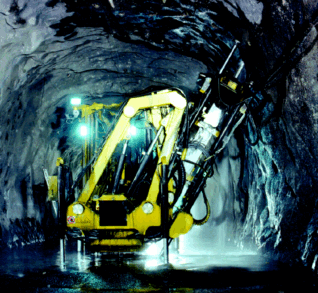 |
| Scaling up from 12 to 28 m between levels and drifts, drifting was reduced by 70% and the volume per drilled meter increased by 500%, according to LKAB. |
“We are delighted to unveil the new Flygt BIBO,” said Daniel Westin, product manager at Xylem. “The reliability and capability of the original Flygt BIBO dewatering pump is renowned within the industry and set the standard for submersible dewatering when it was first launched in the 1960s. More than 1 million of the original pumps have been sold since it was first brought to market. This celebrated design forms the core of this new generation of Flygt BIBO pumps that now include the most advanced pumping technology, bringing the best in dewatering pump capability to the market.
“Xylem’s new Flygt BIBO includes several innovations such as our DuraSpin hydraulic system for unmatched wear resistance, a new plug-in seal and a single impeller-adjustment screw. All of these innovations work together to deliver our customers a pump with high uptime capability and a limited and low-cost service requirement,” Westin said.
Xylem’s new Flygt BIBO is available in four models, 2830, 2840, 2860 and 2870, capable of handling flows of up to 100 l/s (1,600 gpm), heads up to 80 m (300 ft) and solids up to 12 mm in diameter. Available with power ranges from 3.7 to 18 kW and (6 to 27 hp), this series of pumps is engineered for professional use in the harshest of environments.
Water-powered Drilling
For 20 years Swedish iron ore miner LKAB has used water-powered technology to improve underground production drilling while at the same time reducing energy consumption. Its production blastholes are now twice as long and each blast provides eight times more ore. Now Wassara is offering the rest of the world the same opportunity.
In the 1980s, LKAB faced a great challenge, scaling up its production. To achieve some high goals, the company needed more efficient mining, reducing production costs dramatically. The blastholes needed to be drilled longer and much straighter. Intensive development began and one solution to the problem was to use water for power transmission.
To power the down-the-hole (DTH) hammer, LKAB used air, and so did everyone else. Using water instead of air for both powering and lubrication of the equipment, they wanted to increase drilling. Longer and straighter blastholes would yield more iron ore per blast, an important part of lowering the production cost. Using water would also improve the work environment by minimizing oil mist and dust in the air.
The new water-powered drilling technology proved to be able to drill both straighter and deeper into the ore body. Today LKAB has increased its blast hole depth to 56 m, compared to the previous 28 m.
Each blast now gives eight times more ore than before. The water-powered drilling technology is an essential part of LKAB’s great success in the world market. Wassara’s water-powered drilling technology has now been used to drill more than 18 million m of blastholes.
In 1988, LKAB was one of the founders of G-Drill. It would continue to drive the development of the water-powered drilling technology. The aim was also to find other industries where the water-powered drilling technology would make the same benefit as it did for LKAB. In 2002, the subsidiary changed its name to Wassara and in 2012, it upgraded to LKAB Wassara. The goals are still the same. In recent years, Wassara has been building an organization designated to handle the market demand from new areas such as ground engineering, dams and exploration drilling.
“We now have the technology, resources and references to achieve success,” said Kent Boström, communications manager at Wassara. “We can now show several examples of demanding applications where the water-powered drilling has been absolutely superior to other drilling technologies.”
The heart of the system is its worldwide patented Wassara DTH Hammer, using water for power transmission. The drilling technology is suitable for most applications, particularly in applications that are difficult or unsuitable to drill in with other drilling technologies.
Using water is optimal because it cannot be compressed. The amount of water leaving the hammer is the same as has been fed to the system. The minimal pressure loss means that the power is unchanged no matter how far one is drilling. This means that the drilling efficiency is equally high regardless of whether the bore is 10, 100 or 1,000 m.
Using water for power transmission also means that the power fully reaches the hammer, enabling drilling in smaller borehole dimensions. Today, the water-powered drilling technology can be used for drilling holes with diameters from 65 to 254 mm. The water pressure is up to 180 bar, compared to 30 for air. The difference is noticeable on the stroke rate. A Wassara hammer gives 3,600 blows per minute (60 Hz), while an air-powered hammer gives 2,000-2,700 blows per minute (35-45 Hz).
The precision was also important for LKAB when the technology was developed. Several tests indicate that the deviation of a borehole is around 1%-2% in a 200-m borehole, to be compared with deviation of about 15%-20% when drilled with air-powered technology.
Power consumption is reduced significantly:
- To power a 6-in., air-powered DTH hammer, a compressor that gives 570 l/s at 35 bar is required; the required power is 430 kW.
- To power a 6-in., water-powered DTH hammer, a high-pressure pump that gives 490 l/min at 200 bar is required; the required power is 190 kW.
LiuGong Expanding into Large Size Machines
Go big or go home. This is a popular phrase LiuGong Machinery Corp., Asia’s leading full-line equipment manufacturer, takes seriously. In the past four years, the company has quietly expanded its ability to produce large-sized construction equipment machinery. Through smart acquisitions, redirection of some of its R&D efforts and new partnerships, LiuGong now has added large tonnage machines to the top end of several of its key product lines, including excavators, bulldozers, wheel loaders, rigid dump trucks and electric mining trucks.
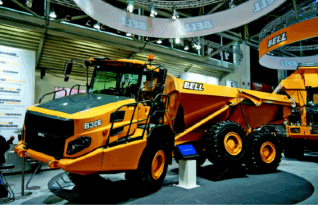 |
| Bell Equipment introduced its new E-series of articulated dump trucks. |
“We add larger sized machines to the top end of our lines when we have the right things in place to design and produce them, and to also service and support our customers,” said David Beatenbough, LiuGong’s vice president of R&D. “Producing these machines requires a certain degree of specialization. That’s why our 899 wheel loader was our first foray at the larger machines. We have such a deep experience and reputation with wheel loaders and such a vast product line—it was just a natural for us to start there.”
Beatenbough added that LiuGong’s acquisition of Dressta in 2012 further expanded the company’s expertise in bulldozer and track technology. Dressta had a suite of very large machines, and LiuGong is benefiting from Dressta’s historic and collective knowledge, he said.
“We have two teams running cooperative projects between our Poland facility and China right now. One is to develop an even larger mining wheel loader, and one to develop mining bulldozers,” Beatenbough said.
Many of these products, including the larger sizes that are in development, will eventually enable LiuGong to address the needs of the mining sector.
In 2009, LiuGong introduced its CLG 899 wheel loader powered by a 391 kW Cummins engine. The CLG 899 now represents the top end of LiuGong’s expansive 13-model wheel loader line. With an operating weight of 50,000 kg and a 6.7 m3 bucket capacity, the machine is capable of safely carrying loads with a top speed of nearly 35.1 km/h in forward and reverse. Its maximum dump clearance of 3,365 mm, allows it to work alongside LiuGong’s new rigid mining dump trucks.
When LiuGong acquired 42% of mining truck manufacturer Beijing Capital Steel Heavy Duty Truck Co. Ltd. in 2011, LiuGong began producing rigid body dump trucks, and now offers the SGR 50A. Powered by a 391 kW Cummins diesel engine, the 27,000 kg machine has a payload capacity of 50,000 kg. It can travel safely at speeds up to 56 km/h and with its 25-second hoist time and 18-second lower time, it’s both speedy and efficient.
Bell Equipment Announces New Products
“bauma 2013 was a fantastic experience for Bell. It was the biggest bauma we have attended as well as the largest international exhibition Bell has produced,” said Bell Equipment CEO Gary Bell. “We were well positioned with a sizeable display in Hall B4, indicating that we are moving up the ranks in terms of European equipment suppliers, and enjoyed a high volume of foot traffic throughout the show.”
Attracting the interest of visitors was the company’s new E-series Articulated Dump Truck (ADT), the proven D-series range and the VersaTruck program—a broad range of products confirming the company’s reputation as a true international ADT specialist in all variations of ADT trucks.
Bell Equipment’s new E-series was officially introduced to the market at bauma 2013 with a Bell B30E (240 kW; 28 mt) on the company’s indoor stand and a B25E (210 kW; 24 mt) at the open air presentation of Nagel, one of the company’s German dealers.
“We had a large engineering contingent at the show to benchmark our E-series product against the rest of the major role players,” Bell said. “This, together with the overwhelming response from visitors to our stand, has left us confident that the investment we have made in the engineering of this latest generation of trucks will keep us at the forefront of ADT innovation by offering customers unrivaled value in terms of performance, fuel efficiency and the operator experience.”
The company’s proven D-series range of ADTs was represented in Munich by the flagship B50D, which remains the world’s only production 50-tonner. “With a strong heritage, the D-series still offers true value to customers, setting its own ‘Blu@dvantage’-standards in terms of fuel consumption and return on investment,” said Bell.
Meanwhile, in line with general market trends, Bell said the company sees more demand from the mining sector. “We’re performing well in the mining industry with dedicated products including the B50D and productivity boosting services such as our satellite fleet management tool, Fleetm@tic, as well as our full-coverage after-sales program, Bell Assure,” Bell said.
The company also announced Bell Trucks America (BTA), which has been established in Houston, Texas, as part of its strategy to re-enter the Americas with the Bell brand following 10 years of supplying product to these markets under another brand. BTA is a joint venture by Bell and major investors that will serve as Bell Equipment’s American headquarters, responsible for setting up a comprehensive network of regional dealers and service partners across this territory. This important decision regarding the manufacturer’s global market coverage follows the cooperation agreement with the nationwide Canadian dealer, Wajax, the first ADTs for which have already left the Bell factory in Eisenach, Germany.
In the Americas, Bell will start by introducing the larger D-Series trucks, which will see the “heavyweights,” the B45D and B50D, available in the North American markets for the first time. The full Bell range, with the new E-Series small trucks will be available from the beginning of 2014. All Bell Equipment activities in North America will be monitored through its own company, Bell Equipment North America (BENA). This includes the exclusive supply of Tier 4i-compliant trucks and parts from the Bell facilities in Germany, namely the Eisenach production facility and the European Logistics Center in Alsfeld. “We’re extremely focused on this development, as this will generate important sales through all the truck classes, as well as secure our European production and parts activities in the long term,” Bell said.
Bell Equipment will also intensify its South American business through cooperating with strong partners and being active in several Latin and South American markets. The supply and support of respective units will be managed by Bell Equipment International Operations.
Hydraulic Hybrid Concepts
Dana introduced the Spicer PowerBoost System, a new line of integrated hydraulic-hybrid powertrain concepts for the off-highway market, at bauma 2013. Deployed through series or parallel hybrid configurations that fit into existing vehicle designs with minimal adaptation, Spicer PowerBoost supplements all types of transmission architectures.
The system captures kinetic energy otherwise wasted throughout the drivetrain and working hydraulics, and then uses this recuperated energy to help power the vehicle, which can reduce fuel consumption by 20% to 40% compared to conventional drivetrain concepts, depending on vocational application and duty cycle. It can also reduce total owning and operating costs by increasing productivity, reducing maintenance, and allowing for the use of a downsized engine.
Functional prototypes demonstrating the performance of the system will be available for field testing by OEMs in the second quarter of 2013.
“Dana has pioneered powertrain innovations for more than a century, and Spicer PowerBoost exemplifies an ongoing commitment to research and development that leverages our extensive systems knowledge and increases value to both our OEM customers and end users,” said Aziz Aghili, president of Dana Off-Highway Driveline Technologies. “In an era when equipment manufacturers are finding it difficult to identify incremental gains in efficiency, this technology offers a tremendous leap forward in productivity and reduced costs that easily fits into existing design envelopes.”
Spicer PowerBoost uses an advanced energy-management system to evaluate the levels of power needed in the entire vehicle system, predict operating demands, and determine the most efficient means of operation. Hydrostatic energy is captured in an accumulator from the powertrain during low-power operation of the engine and recuperated from braking and working.
When additional power is required, such as accelerating from a full stop, lifting a load, or driving into the pile, the advanced energy-management system uses the stored energy in the accumulator to provide an additional source of power for improving performance, increasing productivity, and reducing fuel consumption. The Spicer PowerBoost system can also be configured to minimize idling by shutting off the diesel engine and accessing power captured in the accumulator for vehicle operations that consume low amounts of energy, such as inching, light working conditions, and low travel speeds.
Spicer PowerBoost solutions are ideal for applications with frequent, intense bursts of acceleration, deceleration, lifting, and lowering during cyclic maneuvering that support the recuperation of working and braking energy. Construction equipment, material-handling machines, and on-highway vocational vehicles are the initial targets for Spicer Powerboost.
The system provides the additional power needed for energy-consuming activities such as driving into a pile or lifting a load, it enables machine manufacturers to reduce the engine size for power outputs from 55 to 250 kW (74 to 335 hp) across a wide range of vehicle applications.
Volvo Penta Offers Start-stop Engines
In the March 2013 bauma preview, E&MJ readers might recall that Volvo Penta was one of the first diesel engine manufacturers to receive stage 3B and Tier 4i certificates for its entire engine lineup. The company also announced the Volvo Penta 13L Tier 4i diesel engines were the first engines to be certified by the U.S. Mine Safety and Health Administration and the Canadian Center for Mineral and Energy Technology-Mining and Mineral Sciences Laboratories.
At bauma, Volvo Penta debuted new start/stop functions for diesel engines. It has become more and more common lately in passenger vehicles—the clever function that stops the car engine as the car stops at, for example, a stop light. Now Volvo Penta has introduced start/stop functionality for industrial engines, which could help operators reduce fuel consumption by 5% or more.
The automatic start/stop function works in the same manner as in a private car. When the machine’s engine is idling, the engine is turned off after a pre-set time span—usually 5–10 seconds. And, when the driver activates any of the machine’s controls, the engine starts immediately and the work can continue.
The automatic start/stop function is an optional accessory. In operation, it can be deactivated/reactivated when needed.






